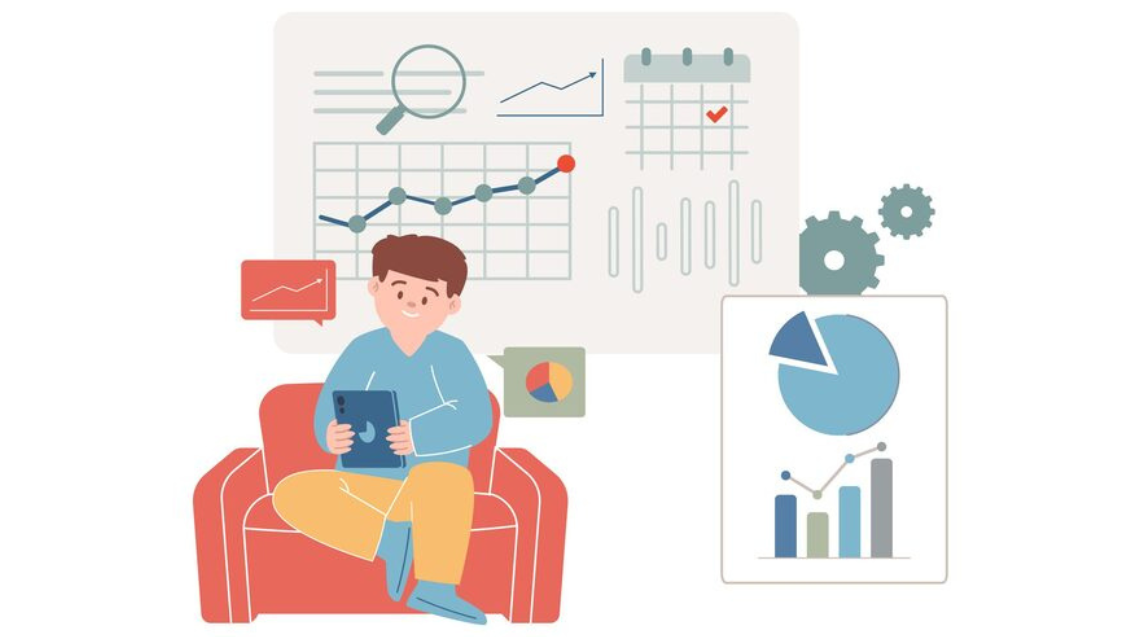
Statistics play a very important role in our daily lives. Everyone is using statistics without even knowing it. It is all around us in shaping decisions, influencing outcomes, and revealing patterns we may not have noticed otherwise. From the grocery store to the stock market, from healthcare to sports, statistics is everywhere, quietly guiding the way we understand and navigate the world around us. Everyone is a statistician to some degree.
It is not always possible to collect data from the entire population. Starting from the kitchen, we pick one or two rice to check the cooked rice. We are using sample Statistics. For Market Research companies use sampling techniques to gather information about consumer perceptions about products. During the Election, Pollsters use sampling to predict public opinion without having to survey every individual. In the manufacturing process, sampling is used to assess the quality of products instead of inspecting every item. In Health studies, Doctors take a blood sample to study the disease and also take a sample of individuals to assess the effectiveness of medical intervention. TV networks use sampling to estimate viewership ratings. Instead of monitoring every viewer, a sample group is used to gauge the popularity of different programs. scientists may collect samples of air, water, or soil in specific locations to understand pollution levels and ecological health. During financial audits, auditors often use sampling techniques to examine a subset of financial transactions and records. This helps them assess the accuracy and reliability of financial statements
Retailers keep track of everything they sell and use statistics to find out about stocks. They use inventory management as part of the statistics to determine how much stock to order. Statistical techniques are used to assess the value of inventory on hand, which is crucial for financial reporting and decision-making Statistical analysis is used to fine-tune these systems and optimize the timing of orders. In daily life, individuals also engage in informal inventory management, such as managing household supplies, groceries, or personal items.
A company makes thousands of products every day and sees to it that they sell the highest quality goods. A company can't test every product. So the company uses quality testing with the help of statistics. Quality control is critical in healthcare, where it ensures the accuracy of diagnostic tests, the safety of medications, and the reliability of medical equipment. Statistical methods are applied in clinical trials, pathology labs, and pharmaceutical manufacturing to maintain high standards.In our daily life Before embarking on a journey, people perform safety checks on their vehicles, such as checking tire pressure, brake function, and fluid levels. These checks are a form of quality control to ensure the vehicle's reliability and safety.
Ever wondered how supermarkets determine the best placement for products? Statistics plays a pivotal role in analysing consumer behaviour, allowing retailers to optimize layouts, stock shelves strategically, and offer discounts that resonate with shoppers. Your shopping experience is subtly orchestrated by the symphony of statistical insights derived from countless transactions.
Large datasets cannot be easily analyzed by hand, but now it is more convenient to manage large data with the help of statistical software. Big data facilitates the analysis of spatial and temporal trends. This is particularly valuable in fields such as environmental science, epidemiology, and urban planning where understanding geographic and temporal patterns is crucial. Analysing large volumes of text data, such as social media posts or customer reviews, allows statisticians to gain insights into public opinion, sentiment, and trends. This information can be valuable in market research and social sciences.
Banks use data to reduce risk, analyze activity in financial markets and assess the impact of financial crises, which can help them make informed investment decisions and provide efficient and customized services to customers. Banks use time series analysis to understand and predict changes in interest rates. This information is critical for managing the interest rate risk in a bank's portfolio and making decisions about lending and investment activities. Statistical techniques are employed to detect unusual patterns and anomalies in financial transactions, helping to identify potential fraudulent activities.
In government, the use of statistics contributes to transparent governance, evidence-based policy decisions, and the efficient allocation of resources to address the needs of the population. Government departments conduct censuses to gather comprehensive demographic data. This information is crucial for understanding population dynamics, demographic trends and planning public services such as education, healthcare, and housing.
Statistical methods are used to evaluate the impact of policies and programs. This involves analyzing data before and after the implementation of policies to assess their effectiveness and make informed adjustments. Statistical data is used to monitor and analyze economic indicators such as GDP, inflation rates, employment rates, and industrial production. This information is critical for economic planning, policy formulation, and assessing the impact of economic policies.
Statistics play a crucial role in healthcare across various domains, aiding in data-driven decisionmaking, medical research, patient care, and health policy development. Statisticians are involved in drug discovery, testing, approval and marketing. Before prescribing any drug, the scientist must show a statistically valid effect. Statistical analysis is used to assess patient outcomes, survival rates, and complications. This information helps healthcare providers identify best practices, evaluate treatment effectiveness, and make evidence-based decisions. The integration of statistics enhances the understanding of diseases, improves patient care, and informs policy decisions.in healthcare
The application of statistics in agriculture is essential for optimizing production processes, improving resource efficiency, and addressing challenges related to climate variability and market dynamics. As agriculture continues to evolve with advancements in technology, data collection, and analytics, the role of statistics becomes increasingly prominent in shaping the future of sustainable and efficient farming practices. Statistical methods help in analyzing water usage patterns, predicting water requirements for crops, and optimizing irrigation practices. This supports sustainable water management in agriculture. Statistical decision support systems integrate data on weather, soil, and crop conditions to provide real-time recommendations to farmers. These systems help optimize planting schedules, irrigation, and pest control measures.
Whenever an election comes, the election reporter evaluates the election winner based on the political campaign. Statistical techniques are employed to design and analyze political polls and surveys. Polling data provides insights into public opinion, candidate popularity, and potential election outcomes. Statistical sentiment analysis of news articles, social media posts, and public discussions helps campaigns gauge the overall sentiment toward the candidate, issues, or the political landscape. After the election, statistical analysis is used to assess the campaign's overall effectiveness, understand voting patterns, and analyze factors contributing to the election outcome
Statistics plays a critical role in the insurance industry, influencing various aspects of risk assessment, premium pricing, underwriting, and claims management. Insurance companies use statistical models to assess the risk associated with insuring individuals or entities. Actuaries analyze historical data, demographic information, and other relevant factors to determine the likelihood of a policyholder filing a claim. Statistical analysis is used to set appropriate premium rates for insurance policies. Actuarial models take into account the expected cost of claims,administrative expenses, and profit margins to determine the optimal pricing structure. With the increasing prevalence of cyber threats, insurers use statistical models to assess and quantify cyber risks. This includes analyzing data breach probabilities and estimating potential financial losses. mortality and morbidity data is also analyzed to set appropriate premiums for life insurance and long-term care policies.
Another area where we can look at statistics is the stock market. Stock analysts also use statistical computer models to predict what is happening in the economy. Statistics in the share market provide tools and methodologies for investors, analysts, and traders to make informed decisions, manage risks, and optimize their portfolios. Investors and analysts use Monte Carlo simulations to model the probability of various outcomes and assess the potential risks and returns associated with different investment scenarios. Statistical methods like moving averages help smooth out fluctuations in stock prices, making it easier to identify trends. Traders use moving averages to spot potential entry and exit points.
Whether you're an avid sports fan or a casual observer, statistics plays a key role in enhancing the viewing experience. From player performance metrics to win-loss probabilities, sports analytics leverages statistics to provide a deeper understanding of the game. It's not just about scores; it's about unravelling the story hidden within the numbers.
Everyone sees the weather forecast. Have you ever wondered how you can get this information? Some computer models are built on statistical concepts. These computer models compare the past environment with the current environment and predict the future environment. Meteorologists use descriptive statistics, such as mean, median, and standard deviation, to summarize historical weather data. This helps in understanding the typical weather patterns for a specific location and time. They use regression models to identify relationships between various atmospheric variables. For example, regression analysis may be employed to predict temperature based on historical data for temperature, humidity, and other relevant factors. Geostatistical techniques are used to analyze spatial variability in weather phenomena. This is particularly important for predicting localized weather events, such as rainfall or wind patterns. Extreme events, such as hurricanes, heat waves, or heavy rainfall, require specialized statistical methods. Extreme value theory helps estimate the likelihood of rare and extreme weather events
If you are on a diet, check your calories with the help of an app that uses statistical data to provide results. The cab booking application is also based on statistical data. Some prescriptions are again statistically based when you shop online. Statistics plays a crucial role in various aspects of mobile applications, from development to user experience optimization. Mobile app developers use statistical methods to analyze user behavior within an application. This includes tracking user interactions, navigation patterns, and feature usage. Tools like Google Analytics or Mixpanel are commonly used to gather and analyze this data.
Statistics is a fundamental tool in both natural and social sciences. It provides a systematic way to collect, analyze, interpret, present, and make inferences from data. Statistics allows scientists to quantitatively analyze measurements, whether it's the height of plants, the concentration of a substance, or the velocity of an object. In natural sciences, researchers use statistical tests to determine if observed results are statistically significant, helping to decide whether to accept or reject hypotheses. Sociologists use Statistics to analyze social trends, psychologists employ statistical methods to study behaviour, and political scientists rely on it to understand voting patterns and societal dynamics. Almost all fields of science such as biology, chemistry, physics, etc. use statistical methods to experiment and analyze their results. In both natural and social sciences, statistics provides a common language for researchers to communicate and validate findings. It is an essential tool for making informed decisions, drawing meaningful conclusions, and advancing our understanding of the world
In the world of finance, where uncertainty is constant, statistics provides a compass for investors. analysing historical market data, predicting future trends, and assessing risk—all crucial aspects of financial decision-making—are made possible through statistical models. Your investment portfolio may be diversified, but its foundation is built on the principles of statistical analysis.
In education, statistics guides policy decisions, measures academic performance, and identifies areas for improvement. Standardized testing, graduation rates, and educational research all draw upon statistical techniques to provide insights into the effectiveness of teaching methods and the overall health of educational systems.
In conclusion, statistics is not confined to the pages of textbooks or the offices of data scientists. It is a dynamic force that permeates every aspect of our lives, providing a lens through which we can understand, interpret, and navigate the complexities of the world around us. As we navigate an increasingly data-driven world, the significance of statistical methods continues to grow, reinforcing the idea that, indeed, statistics is everywhere.
